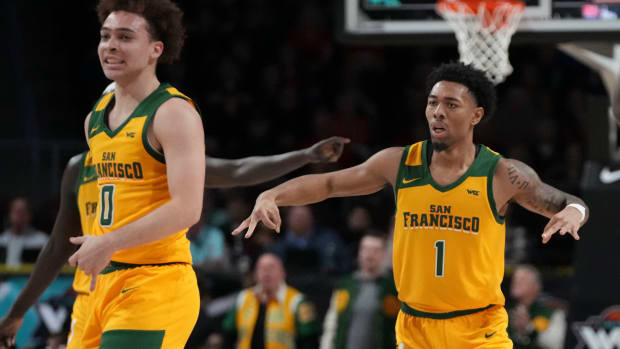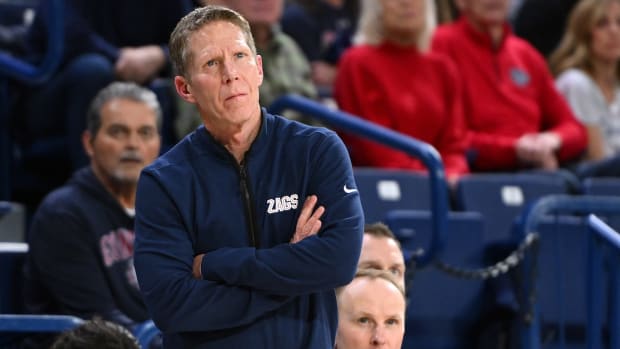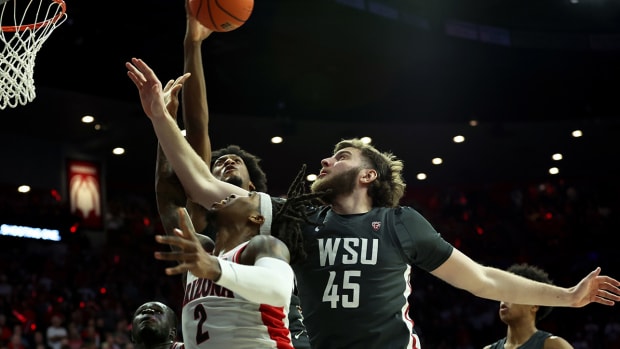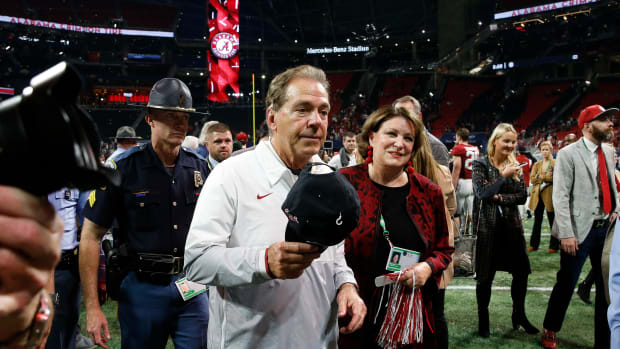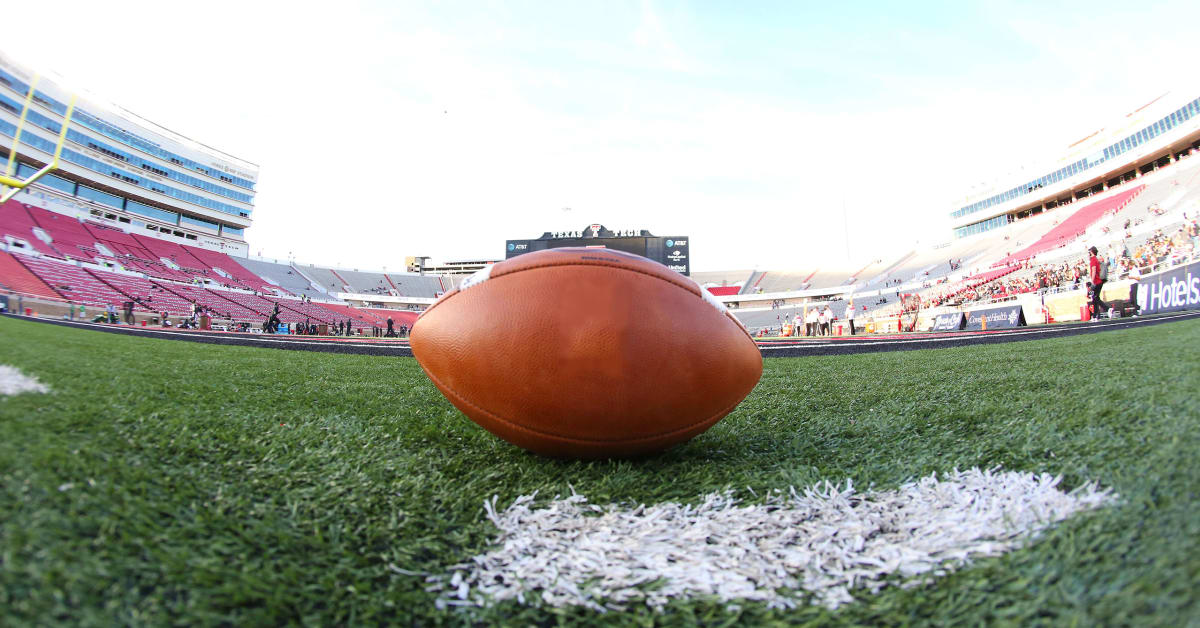
‘The Next Wave Is Coming’: Expansion, Realignment and What’s at Stake for Power 5 Conferences
Two weeks ago, inside a lavish resort in suburban Phoenix, down a long hallway and two flights of stairs, executives from two conferences inched closer to further altering the landscape of college sports.
They talked about expansion.
Often sparring publicly with one another, the two sets of league administrators separately met behind closed doors like a pair of boxers secretly preparing for the big fight against each other.
In one corner was the Pac-12, an array of broad-based universities, betrayed by their Los Angeles defectors and now at the mercy of media networks to prevent further departures.
In the other corner is the Big 12, an expanding group of universities, spanning Utah to Florida, with a brash commissioner whose aggressive nature makes him a territorial threat to the West.
The juxtaposition of the scene was fascinating—a mere 20 feet of carpet separating the two meetings within a labyrinth of convention space at the Hyatt Regency Gainey Ranch.
Within the meeting rooms, each league’s strategy unfolded ahead of their proverbial territorial battle. Just paces from the Pac-12’s gathering, Big 12 leaders discussed a list of expansion targets, four of them residing in the Pac-12: Colorado, Arizona, Arizona State and Utah.
Other targets are from a variety of leagues: San Diego State and UNLV from the Mountain West; UConn, which is independent in football and in the Big East in basketball; and Memphis, from the American. There are others, too, such as Colorado State, SMU and Fresno, but they seem further down the pecking order.
The Pac-12, meanwhile, discussed its own expansion possibilities: San Diego State and SMU.
“It could be an active summer,” says one administrator with knowledge of the discussions.
The near-yearlong realignment buzz surrounding these two conferences—will Pac-12 members defect to the Big 12?—is entering what appears to be its final chapter. Over the next 30 to 60 days more clarity is expected as the Pac-12’s new television deal is finalized.
But this is a small piece of a larger puzzle.
The Big 12-versus-Pac 12 territorial fight is one battle in a realignment war that has waged for decades. While the most recent moves were about the consolidation of football’s most valuable brands—Texas and Oklahoma to the SEC, and USC and UCLA to the Big Ten—the next wave is about survival.
How do the Big 12, Pac-12 and ACC keep up competitively while generating millions less than college football’s two behemoths?
Some believe all three of them cannot coexist successfully.
“The big next issue is, can we keep the perception of college athletics as involving all of us?” asks Notre Dame athletic director Jack Swarbrick. “Or, does the Big Ten and SEC become college athletics in terms of popular perception, and, if they do, how does that influence shape the future of college athletics?”
The ACC
This week in Amelia Island, administrators from the ACC gather for their own spring meetings.
More frank discussions are expected about the growing revenue gap between it and the SEC/Big Ten. Handcuffed by an ESPN broadcasting contract and grant-of-rights that extends another 13 years, ACC schools could find themselves more than $30 million behind the SEC and Big Ten in annual distribution by the time 2026 arrives.
They are not alone, as the data and analytics company Navigate showed in projections last year.
While the Pac-12 and Big 12 fight their western expansion battle, the ACC is, in many ways, fighting internally.
A subset of seven schools in the 14-member conference has coalesced over what many of them describe as an untenable situation. Officials from the seven schools, led by Florida State and Clemson, have met a handful of times over the past several months, with their lawyers examining the grant-of-rights to determine just how unbreakable it is.
Per the grant-of-rights, each ACC school gives ownership of its broadcasting rights to the league in a deal with ESPN that runs through 2036. If a school breaks the deal, the ACC will continue to own the TV rights of any of that school’s home games, according to the contract.
The ACC’s options are quite limited, both for the group of seven and the league as a whole.
1. Seek additional revenue from ESPN. This is a long shot given the network’s current situation. ESPN, in the midst of a wave of personnel cuts, is also negotiating deals with UFC/WWE, the NBA and Pac-12. While commissioner Jim Phillips and a few ACC presidents met recently with the network over this issue, no significant cash infusion appears imminent.
2. Secede from the league. Some of the schools, possibly the most frustrated lot such as FSU and Clemson, could pay the $120 million exit fee and hope they can break a grant-of-rights agreement that most attorneys—though maybe not their own—say is airtight. That then leaves a very big question: Where do they go? The SEC and Big Ten seem quite comfortable with their current membership, but potential western realignment could trigger them to expand more.
3. Create another league. If the seven agree to dissolve the current grant-of-rights agreement (we don’t know yet if this is a possibility), they may add a couple of more schools and begin their own association in hopes of it being more lucrative. This comes with its own issues, of course. You’d need a broadcast partner or private equity to fund such an endeavor. And, as one official asks, “Will it really be that much more lucrative?”
Basically, there are no easy answers.
No one seems to really be blaming the current commissioner, Phillips. The lengthy ESPN contract was signed by his predecessor and has put the conference at a disadvantage to the Big Ten and SEC, which signed new deals somewhat recently for more heftier payouts.
“It’s not a Jim Phillips thing,” says one high-ranking ACC official. “It’s a revenue thing.”
A fourth option for the league will be further explored this week at meetings: changing the revenue distribution model to a more merit-based system. Instead of equally distributing revenue, this system would award more dollars to those programs excelling on the field.
Administrators have spent the last couple of months discussing this festering issue. It has divided a conference that is less like-minded than most leagues in the country: big football revenue-generators like Florida State, Clemson, Miami and even North Carolina grouped with the likes of Boston College, Syracuse and Wake Forest.
While a vote on a revenue distribution model isn’t expected this week, proposals are likely to be explored as university presidents are now examining the issue.
During a Board of Trustees meeting in February, FSU athletic director Michael Alford seemed to publicly fire a warning shot at the rest of the conference: Change the revenue distribution model or else.
“At the end of the day for Florida State to compete nationally, something has to change going forward,” Alford told his board in a wide-ranging presentation in which he suggested that FSU brings in 15% of ACC media rights value but receives only 7% in distribution.
However, any change in the distribution model falls short of significantly closing the gap between the SEC and Big Ten. In the most successful year under a merit-based model, a school might receive an extra $5 million, one administrator estimates.
An unequal distribution model can also impact the culture of a conference. It can sow divisiveness within a league, says one athletic director from outside the ACC.
“It won’t stop there,” the AD says. “This will be the beginning of the end.”
The Big 12 and Pac-12
Back to that fight out West.
The Pac-12-Big 12 realignment battle will either cause small ripples across the national landscape (this happens if the Pac-12 remains intact), or trigger a tidal wave of change stretching from coast to coast (this happens if the Pac-12 has more defections).
It all hinges on the viability of the Pac-12’s new broadcasting contract, both from a financial and visibility perspective (sure, the money could be better or the same as the Big 12, but what if most of the games are on streaming?). The league is in the 10th month of negotiations. And believable details from those negotiations have been scarce.
The Pac-12’s potential instability has been the single most speculated subject across the college sports landscape over the past few months. Through it all, the conference has publicly shown confidence in the face of assumptions of its impending doom.
One experienced executive describes the entire situation as the most “perplexing” he’s ever witnessed in media rights negotiations.
Factions have formed.
Those inside the Big 12, gunning for Pac-12 defections, believe the league is cooked. Those in the Pac-12, wanting to protect its 10 schools, believe the league will arrive at a strong-enough deal coinciding with a short grant-of-rights (four to six years). And then there is the media, which has produced varying reports of the situation, even sometimes sparring with one another over those reports.
One thing is certain: The Pac-12 plans to expand by adding San Diego State and maybe SMU coinciding with its completion of a new TV deal. But there is a deadline. To start play in 2024, San Diego State owes the Mountain West an exit fee of about $17 million. That triples in cost July 1, a reason for a quasi-deadline to the situation.
One athletic administrator offers his own prediction on the outcome: “I think the highest odds—and it may not be more than 50%—is that the Pac-12 salvages something in the short term to keep it together and it is Dead Man Walking for four years, with the Big Ten and Big 12 sitting there.”
But what if it doesn’t salvage something?
Big 12 commissioner Brett Yormark is aggressively pursuing expansion targets in an attempt to reach 14 or 16 members. Top priority are the Arizona schools, Colorado and Utah, but there are plenty of other potential replacements if the Pac-12 programs choose to stay.
Though San Diego State seems bound for the Pac-12—it is their preference—Yormark has held conversations with the school’s leadership about being the Big 12’s only program in the Pacific Time Zone. UConn, the reigning men’s basketball champions, is a play for a foothold in the Northeast as well as adding another basketball powerhouse to what currently is the best hoops league in the country. And of Memphis, the Tigers finished as a finalist the last time the Big 12 expanded.
Yormark’s interest in UNLV seems like a calculated maneuver. Pac-12 commissioner George Kliavkoff, a former casino executive who resides in Las Vegas, is slowly shifting the conference’s hub to Sin City. In an interesting wrinkle, could Kliavkoff’s targeting of SMU be a similar play? SMU is located in the Big 12’s own hub city of Dallas.
The Big 12’s expansion decisions could be solidified in a matter of weeks. Conference administrators meet at the end of the month in West Virginia, including school presidents.
The Big Ten and SEC
This past winter, Big Ten commissioner Kevin Warren made a push to expand again, this time targeting Washington and Oregon as a pair of West Coast neighbors to go along with new additions USC and UCLA.
To expand again, more broadcasting dollars (at least $200 million a year) were needed to assure that school distribution remained whole. The most likely broadcasting dollars would come from ESPN or streamers Amazon and Apple. Neither happened.
“It was ‘Show me the money!’ and there wasn’t any money,” says one Big Ten administrator.
Money aside, many of the league’s athletic directors and presidents did not have the appetite for further expansion—and still do not. As one recently told Sports Illustrated, “We are done.” But will that change if the Pac-12 begins to crumble? Will there be any new money, potentially from Big Ten partner Fox or even ESPN?
If there are defectors in the Pac-12 South to the Big 12, the Big Ten could add Pac-12 north schools like Washington and Oregon, at that point desperate for a home, at likely a discount (they’d almost certainly accept a partial distribution rate). And if the Big Ten again expands, what then does that mean for the SEC, which has long fielded interest from ACC schools?
There’s been a long history of interest from the SEC in certain ACC powers as well. In fact, in 1990, when the league voted to expand, officials explored a variety of targets, seriously vetting Florida State before settling on South Carolina and Arkansas. Years later, then coach Bobby Bowden and several athletic administrators involved in the process revealed they turned down an invitation.
Three decades later, the Seminoles are eyeing an exit path, but a route to the SEC isn’t easy. There is little appetite from risk-averse league presidents to entangle themselves in a potentially sticky legal situation over a grant-of-rights. In another note, the league already has a foothold in Florida with the Gators (and as for Clemson, the SEC is already in South Carolina with the Gamecocks). For the SEC, the more attractive options may be schools in new states like North Carolina and Virginia.
For now, the SEC door feels closed, and the Big Ten door seems only slightly ajar. But as is the case with conference realignment, the tide changes quickly.
Everyone is watching the West.
The Pac-12 and Big 12 enter the biggest realignment battle in years, a fight that could expedite what many believe is an inevitability: the football powers consolidating for what seems to be a semiprofessional future model.
“The next wave is coming,” says one Power 5 university president. “It’s not going to stay still. It’s just a matter of when.”
Watch college football this fall live with Fubo. Start a free trial today.

